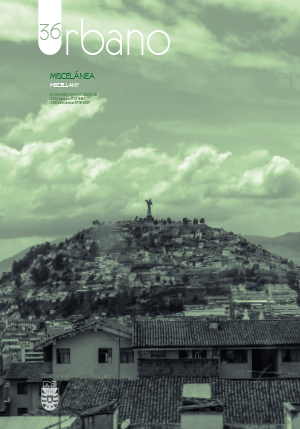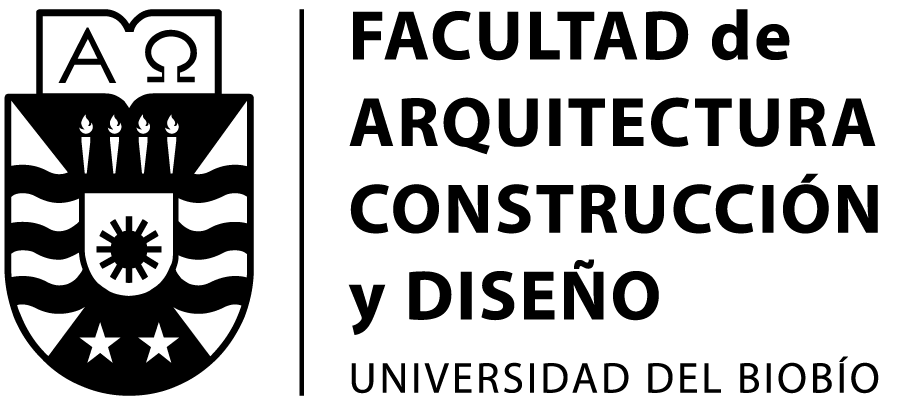The identification of spatial patterns in city limits through Self-Organized maps of the centrality of the road network
DOI:
https://doi.org/10.22320/07183607.2017.20.36.02Keywords:
suburban areas, artificial intelligence, maps, urban morphology, road infrastructureAbstract
The characterization of city limits is of especial interest since it may provide hints to understanding the urban growth taking place in peripheries, and it also makes it possible to identify the keys to the continuous and discontinuous relationships between cities and their surroundings. Within this context, many different approaches could be adopted to undertake this kind of analysis. This paper specifically explores the possibilities offered by the use of self-organized maps created from the results of the application of different centrality measures in the mixed road network, which is comprised of systems of streets, metropolitan roads and rural roads. The implementation of centrality measures to a mixed road network is already an innovative exercise, considering that centrality analyses are normally carried out in more purely intra-urban contexts. The spatial representation of the profiles obtained with the self-organized maps shows different structural characteristics throughout city limits, which can be used to interpret the nature of the boundary itself. The proposed methodology was tested in the city of Granada (Spain), specifically on the limit in contact with the area surrounding the Vega de Granada, a singular agricultural landscape linked to the Genil River.
Downloads
References
ABARCA-ALVAREZ, Francisco Javier y FERNANDEZ-AVIDAD, Ángel. Generation of downtown planning-ordinances using self organizing maps. 10th International Conference on Design and Decision Support Systems, DDSS 2010. S.l.: s.n., pp. 63-79. 2010. ISBN 9789068141818.
AGRYZKOV, Taras; TORTOSA, Leandro y VICENT, José F. New highlights and a new centrality measure based on the Adapted PageRank Algorithm for urban networks. Applied Mathematics and Computation, 2016, 291, pp. 14-29. http://dx.doi.org/10.1016/j.amc.2016.06.036
ANTROP, Marc. Why landscape of the past are important for the future. Landscape and Urban Planning, 2005, 70 (1-2), pp. 21-34. http://dx.doi.org/10.1016/j.landurbplan.2003.10.002
ANVIDA, Analysis and Data Visualization in Net. [Consultado junio 2016] Disponible en: www.anvida.es
BRANDES, Ulrik; ROBINS, Garry; MCCRANIE, Ann. y WASSERMAN, Stanley. What is network science?. Network Science, 2013, 1 (1), pp. 1-15. http://dx.doi.org/10.1017/nws.2013.2
CHOAY, Françoise. Pour une anthropologie de l’espace. Éditions du Seuil, 2006.
CHRISTALLER, Walter. Central Places in Southern Germany. New Jersey: Prentice Hall, 1966.
CLÉMENT, Gilles. Manifiesto Del Tercer Paisaje. Barcelona: Gustavo Gili, 2007.
COHEN, Jacob. Statistical Power Analysis for the Behavioral Sciences. S.l.: Lawrence Erlbaum Associates, Publishers. 1998. ISBN 0-8058-0283-5.
DIAPPI, Lidia, BOLCHIM, Paola y BUSCEMA, Massimo. Improved Understanding of Urban Sprawl Using Neural Networks. En: J.P. VAN-LEEUWEN y H.J.P. TIMMERMANS (eds.), Recent Advances in Design and Decision Support Systems in Architecture and Urban Planning. Politecn Milan, Dept Architecture and Planning, I-20133 Milan, Italy.: Springer, pp. 33-49. 2004. ISBN 1-4020-2408-8.
DUANY A., PLATER-ZYBERK E. SmartCode 9.2. The Town Paper Publisher, 2003.
GEDDES, Patrick. Ciudades en evolución. Oviedo: KrK, 2009.
HAGGET, Peter y RICHARD, Chorley. Network analysis in Geography. London: Edward Arnold, 1972.
HAMAINA, Rachid, LEDUC, Thomas y MOREAU, Guillaume. Towards Urban Fabrics Characterization based on Buildings Footprints. En: J. GENSEL (ed.), Bridging the Geographic Information Sciences. S.l.: s.n., pp. 231-248. 2012. ISBN 978-3-642-29063-3. Disponible en: http://dx.doi.org/10.1007/978-3-642-29063-3_13.
JIANG, Bin. A topological pattern of urban street networks: universality and peculiarity. Physica A: Statistical Mechanics and its Applications, 2007, 384 (2), pp. 647–655 http://dx.doi.org/10.1016/j.physa.2007.05.064
KASKI, Samuel y KOHONEN, Teuvo. Exploratory Data Analysis By The Self-Organizing Map: Structures Of Welfare And Poverty In The World (1996). Neural Networks in Financial Engineering. Proceedings of the Third International Conference on Neural Networks in the Capital Markets, 1996, pp. 498-507. DOI 10.1.1.53.3954. Disponible en: http://citeseerx.ist.psu.edu/viewdoc/summary?doi=10.1.1.53.3954.
KOHONEN, Teuvo. Self-organized formation of topologically correct feature maps. Biological Cybernetics, 1982, [en línea], vol. 43, no. 1, pp. 59-69. ISSN 0340-1200. DOI 10.1007/BF00337288. Disponible en: http://link.springer.com/10.1007/BF00337288.
KOHONEN, Teuvo. Self-Organizing Maps. S.l.: Springer. 1995. ISBN 9783642852152. Disponible en: http://www.springer.com/cn/book/9783642976100.
KRAFTA, Rômulo. Fundamentos del análisis de centralidad espacial urbana, Centro-h, 2008, 2, pp. 52-72.
LÄMMER, Stefan; GEHLSEN, Björn y HELBING, Dirk. Scaling laws in the spatial structure of urban road networks. Physica A: Statistical Mechanics and its Applications, 2006, 363, pp. 89–95 http://dx.doi.org/10.1016/j.physa.2006.01.051
LATORA, Vito y MARCHIORI, Massimo. A measure of centrality based on network efficiency. New Journal of Physics, 2007, 9 (June), pp. 1-12. http://dx.doi.org/10.1088/1367-2630/9/6/188
LIU, Yaolin; WANG, Huimin; JIAO, Limin; LIU, Yanfang; HE, Jianhua y AI, Tinghua. Road centrality and landscape spatial patterns in Wuhan Metropolitan Area, China. Chinese Geographical Science, 2015, 25 (4), pp. 511-522. http://dx.doi.org/10.1007/s11769-015-0749-y
MASUCCI, A. Paolo; SMITH, Duncan; CROOKS, Andrew y BATTY, Michael. Random planar graphs and the London street network. European Physical Journal B, 2009, 71, pp. 259–271 <http://dx.doi.org/10.1140/epjb/e2009-00290-4>
PÉREZ-CAMPAÑA, Rocío; ABARCA, Francisco y TALAVERA-GARCÍA, Rubén. Centralities in the city border: a method to identify urban-rural interventions. Ri-Vista, 2016, 2, pp.38-53.
PORTA, Sergio y LATORA, Vito. Multiple centrality assessment: mapping centrality in networks of urban spaces. En: THWAITES, Kevin; PORTA, Sergio; ROMICE, Ombretta y GREAVES, Mark (eds.), Urban Sustainability through enrivonmental design: approaches to time-people-place responsive urban spaces. New York: Routledge, 2007, pp. 102-109.
PORTA, Sergio; CRUCITTI, Paolo y LATORA, Vito. Multiple centrality assessment in Parma: a network analysis of paths and open spaces. Urban Design International, 2008, 13 (1), pp. 41-50. <http://dx.doi.org/10.1057/udi.2008.1>
PORTA, Sergio; CRUCITTI, Paolo y LATORA, Vito. The network analysis of urban streets: A primal approach. Environment and Planning B: Planning and Design, 2006, 33 (5), pp. 705-725. http://dx.doi.org/10.1068/b32045
PORTA, Sergio; LATORA, Vito; WANG, Fahui; RUEDA, Salvador; STRANO, Emanuele; SCELLATO, Salvatore; CARDILLO, Alessio; BELLI, Eugenio; CARDENAS, Francisco; CORMENZANA, Berta y LATORA, Laura. Street centrality and the location of economic activities in Barcelona. Urban Studies, 2011, 49 (7), pp. 1471-1488. http://dx.doi.org/10.1177/0042098011422570
RAVETZ, J.; FERTNER, C. y NIELSEN, T.S. The Dynamics of Peri-Urbanization. En: NILSSON, K; PAULEIT, S; BELL, S; AALBERS, C, y NIELSEN, Th. A. (eds.). Peri-Urban futures: Scenarios and Models for Land Use Change in Europe. New York: Springer, 2013, pp. 13–44.
SEVTSUK, Andres y MEKONNEN, Michael. Urban network analysis. A new toolbox for ArcGIS. Revue internationale de géomatique, 2012a, 22 (2), pp. 287-305.
SEVTSUK, Andres y MEKONNEN, Michael. Urban Network Analysis. A toolbox for ArcGIS 10/10.1. Help Document. City Form Lab. Singapore University of Technology & Design in collaboration with MIT, 2012b.
SKUPIN, André y AGARWAL, Pragya. Introduction: What is a Self-Organizing Map? En: P. AGARWAL y A. SKUPIN (eds.), Self-organising maps : applications in geographic information science, 2008, S.l.: Wiley, pp. 1-20. ISBN 0470021675. Disponible en: https://books.google.es/books?id=hvWTYUfBFS4C&printsec=frontcover&hl=es#v=onepage&q&f=false.
SPIELMAN, Seth E. y THILL, Jean-Claude. Social area analysis, data mining, and GIS. Computers, Environment and Urban Systems, 2008, vol. 32, no. 2, pp. 110-122. ISSN 01989715. DOI 10.1016/j.compenvurbsys.2007.11.004.
STRANO, Emanuele; VIANA, Matheus; COSTA, Luciano; CARDILLO, Alessio; PORTA, Sergio y LATORA, Vito. Urban Street networks, a comparative analysis of ten European cities. Environment and Planning B: Planning and Design, 2013, 40, pp. 1071-1086. http://dx.doi.org/10.1068/b38216
TAKATSUKA, Masahiro. An application of the Self-Organizing Map and interactive 3-D visualization to geospatial data, Proceedings of the 6th International Conference on GeoComputation, 2001, pp. 24-26.
WASSERSTEIN, Ronald L. y LAZAR, Nicole A. The ASA’s statement on p-values: context, process, and purpose. The American Statistician [en línea], 2016, vol. 1305, no. April, pp. 00-00. ISSN 0003-1305. DOI 10.1080/00031305.2016.1154108. Disponible en: http://www.tandfonline.com/doi/full/10.1080/00031305.2016.1154108.
WEISS, Sholom M. y INDURKHYA, Nitin. Predictive Data Mining: A Practical Guide, 1998, ISBN 1558604030.
WU, Pao Kuan y HSIAO, Tsung Chi. Factor Knowledge Mining Using the Techniques of AI Neural Networks and Self-Organizing Map. International Journal of Distributed Sensor Networks, 2015, vol. 2015. ISSN 15501477. DOI 10.1155/2015/412418.
ZHANG, Jingyuan, SHI, Hao y ZHANG, Yanchun. Self-organizing map methodology and google maps services for geographical epidemiology mapping. DICTA 2009 - Digital Image Computing: Techniques and Applications, 2009, pp. 229-235. DOI 10.1109/DICTA.2009.46.
Downloads
Published
How to Cite
Issue
Section
License
The content of articles which are published in each edition of Habitat Sustentable, is the exclusive responsibility of the author(s) and does not necessarily represent the thinking or compromise the opinion of University of the Bio-Bio.
The author(s) conserve their copyright and guarantee to the journal, the right of first publication of their work. This will simultaneously be subject to the Creative Commons Recognition License CC BY-SA, which allows others to share-copy, transform or create new materials from this work for non-commercial purposes, as long as they recognize authorship and the first publication in this journal, and its new creations are under a license with the same terms.![]()























